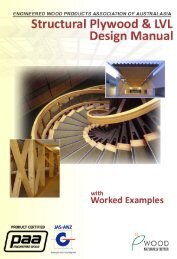Facts About Particleboard and MDF - Engineered Wood Products ...
Facts About Particleboard and MDF - Engineered Wood Products ...
Facts About Particleboard and MDF - Engineered Wood Products ...
You also want an ePaper? Increase the reach of your titles
YUMPU automatically turns print PDFs into web optimized ePapers that Google loves.
Feed speed should not exceed 15m/min. Mechanical feed is best but if h<strong>and</strong> feeding, a steady rate is more<br />
important than precise speed. Projection of the saw above the work piece should be between about 8mm<br />
<strong>and</strong> 20mm.<br />
If chipping is observed on the top face raise the saw, if on the underside lower the saw.<br />
Spindle <strong>and</strong> Router<br />
As <strong>Particleboard</strong> <strong>and</strong> <strong>MDF</strong> have a non-directional grain, grooves, recesses <strong>and</strong> housings can be easily cleanly<br />
cut. These processes are normally carried out on a router <strong>and</strong> tungsten-carbide tipped cutters should be<br />
used. The cutter spindle speed should be 18,000 - 24,000 rev/min <strong>and</strong> the material feed rate 4.5 - 9.0 m/min.<br />
It may be necessary to bring a surfaced panel to size on a spindle or router with the aid of a jig. When<br />
minimal quantities are involved, high-speed steel cutters can be used but they rapidly lose their edge <strong>and</strong> for<br />
quantity production tungsten tipped cutters are necessary. However for large volume producers where<br />
consistent <strong>and</strong> accurate profiling is important, diamond tooling is now being used. Tooling might cost ten<br />
times the equivalent in tungsten carbide, but it will run 50-100 times longer without needing attention.<br />
Panels will have been cut oversize <strong>and</strong> the necessity for careful sawing is again stressed. Any excessive<br />
chipping at this stage inevitably gives rise to hair-line cracks which "chase through" with the impact of spindle<br />
or router cutters. Ideally make a clean saw cut <strong>and</strong> remove the minimum possible by cutter.<br />
Keep cutters sharp. Dull Cutters will cause the edge to "bell" or spread, which will give trouble when<br />
subsequently dressing, edging or lipping flush with the surface. The edges of wood panels can be easily<br />
planed <strong>and</strong> profiled on a spindle machine. Rebates tongues <strong>and</strong> grooves are the types of moulding best suited<br />
to the material <strong>and</strong> profiles should be kept simple. Because the material can be cut easily <strong>and</strong> cleanly the use<br />
of simple joints in assembly is practical <strong>and</strong> economical. It is not possible to lay down precise details but in<br />
general feed speeds should be slower than for solid timber <strong>and</strong> the maximum number of cutting edges<br />
possible provided. The following is suggested:<br />
Speed<br />
Cutter Block<br />
Spindle Machine<br />
4000-10000 rev/min<br />
minimum 4 cutters<br />
Cutters Toe 42 ° Heel 45 °<br />
Material Feed<br />
4 to 5m/min<br />
Speed<br />
Cutters<br />
Material Feed<br />
Router<br />
18000-24000 rev/min<br />
double edge bit minimum<br />
25mm cutting edge ground 53° angle<br />
4 to 5m/min<br />
Drilling<br />
As other processes, cutting edges must be sharp if a clean hole is to be cut. Drill speed <strong>and</strong> the angle of the<br />
drill point should be the same as that used for normal woodworking. When drilling through plastic laminates<br />
the point angle should be between 80° <strong>and</strong> 90° .<br />
25

















